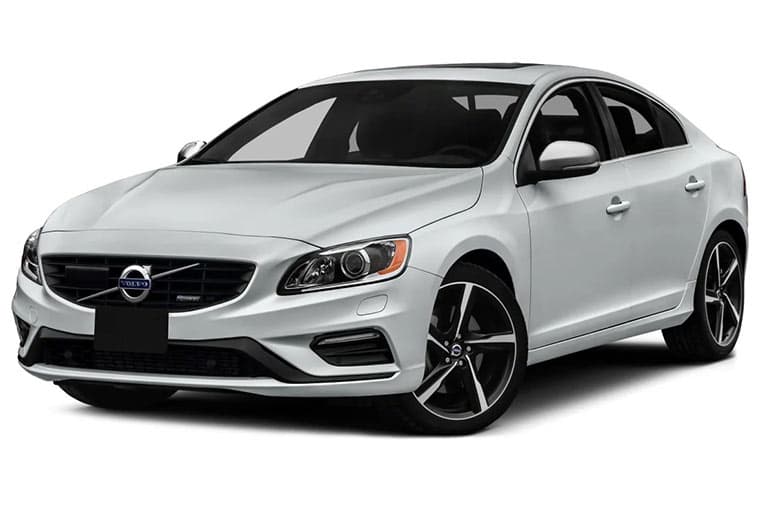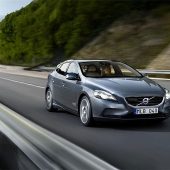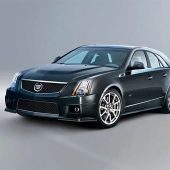Now there’s a new wagon model in the Volvo lineup. The all-new V60 is based on the S60 sedan and technically cars are pretty much the same, V60 offers just a bit bigger boot. Well, actually the difference between S60 and V60 is quite marginal when comparing the cargo space. The S60 has a load capacity of 380 litres, while V60 offers 430 litres to window line. The cargo space is increased to 557 litres when loaded to the roof and with rear seats dropped, capacity is boosted to 1241 litres. So V60 is by no means the most capacious Volvo estate car and even Volvo admits that. But it was never designed to be. Instead it is the most stylish and by far the best to drive. However, as being an estate car, it does have all the handy functionality for which Volvo wagons are famed.
The 1095mm wide tailgate gives good access to the boot area. Rather than the 60:40 that is more usual for wagons, the rear seat backrests can be fold down 40:20:40 sections. The backrests fold forward to give a perfectly flat load area which nicely improves versatility. With rear seats folded, the flat cargo space is just under three metres long. To utilise the longest carrying length, the passenger front seat backrest can also fold flat. Depending on the need, you can accessorise the load compartment with a mat that useful if you regularly carry anything dirty, or with a protective grille to divide the load compartment from the seating area. Protective grille is useful for dogs or to ensure that unsecured packages don’t impede into the passenger area during faster driving. Also available is a tough rear bumper strip to stop scuffing during loading. For family use, the rear seat can be specified with integrated child booster cushions in the outer seats. They are suitable for children weighing from 15-36 kg, and ensure that children sit comfortably and safely. Two-stage height adjustment ensures small children can still get a good view of the scenery. Now we have covered the necessary estate car facts, we can move to more important things, like how it drives.
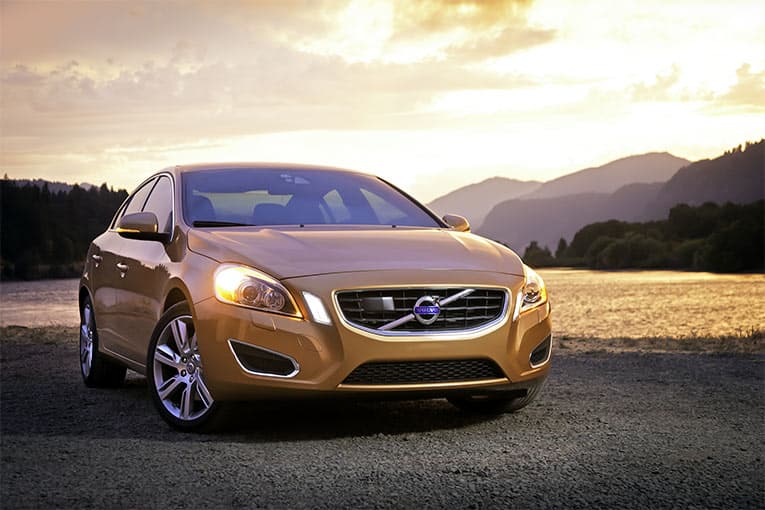
This T6 is the top of the range engine for the new V60. It’s a six-cylinder turbocharged petrol engine, with displacement of 3.0 litres. The straight-six engine is mounted in the engine bay transversely, because transversely mounteed engine reduces the risk of an engine penetrating the passenger load space during a crash. It can also can be designed to have more crumple space in front and behind the engine. Usually the problem with a straight-six is that they’re long and therefore difficult to package transversely. Volvo engineers overcame this problem by making this engine extremely compact and much shorter than the straight-six normally are. Engine has twin overhead camshafts and 24 valves to provide optimal engine breathing. The turbocharger in the T6 is a twin-scroll device that allows for better low-rev response and also reduces turbo lag. T6 produces 304 horsepower and 440 Newton metres of torque, giving this Volvo quite nice performance. Top speed is limited to 250 km/h and in summer confitions you should be able to get from zero to hundred in 6.2 seconds.
To get more traction in winter time the T6 comes as standard with the AWD (All Wheel Drive) system. It is a computer-controlled system that automatically sends torque to the wheels with most grip. The sensors monitor the road surface and the positions of the steering, brake and throttle. Provided by this information, the electronically controlled hydraulic clutch determines the most effective distribution of torque. The front-to-rear torque split changes constantly – from zero to 100 per cent. In normal conditions on a dry tarmac road, almost all the power is distributed to the front wheels. When slippage occurs, torque is provided to the rear wheels to increase the grip. On slippery surface the V60 feels a bit more like a front-wheel drive than an all wheel drive. This can be easily noticed when using throttle while turning. The front wheels start to loose the grip before the torque is provided to the rear wheels. These smart all wheel drive systems are coming quite clever and they can react pretty fast to different circumstances, but they still can’t match the performance of the permanent four-wheel drive system, which just provides so much more fun. With the AWD system you are dependent on the electronics and sometimes that can be a bit boring. However AWD helps standing starts on slippery conditions and helps the T6 to put all its power to the road. It should also provide better fuel efficiency on longer journeys when it’s using only the front-wheel drive. The EU-combined fuel consumption for the T6 is 10,2 l/100 km, but you can easily spend a bit more when you are enjoying the performance of the engine, as you should.
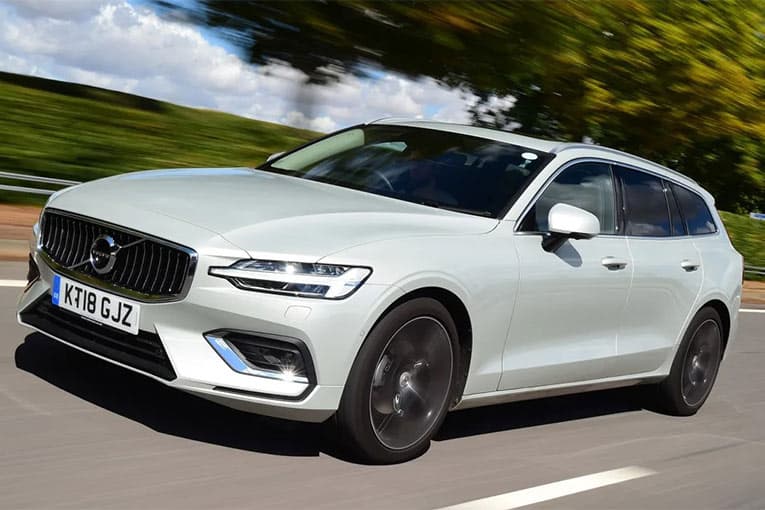
The T6 is mated to Volvo’s six-speed automatic transmission. The second-generation Geartronic transmission has new valves and lower friction for faster gearchanges. The Geartronic has two shift-modes. The normal D-mode, which provides pretty good performance, but normally keeps the revs low for lower fuel consumption. Moving the gearlever to the manual mode first engages the sport mode, which allows higher revs before gear change, slightly faster shifts and sharpens kickdowns. Naturally you can also change gears yourself by moving the gearlever in the manual mode front and back. Eventhough gearchanges should be quicker with this second generation Geartronic, there still is annoying delay when you want to change gears by yourself in the manual mode. Therefore it is more enjoyable to let the automatic do all the work. For daily driving the normal D-mode is the best, while S-mode (sport) is best when you are about to overtake or just want to enjoy more of the cars performance on open roads.
The V60 has exactly the same suspension as the new S60, except that the suspension bushes are slightly different to compensate for its marginally greater weight. If you want to adjust your suspension for different road conditions, there is also an option for Volvo’s Four-C suspension. In Four-C the electronic sensors continually monitor the car’s behaviour and adjust the dampers in a fraction of a second to offer optimal handling and ride. The advanced multiplex control systems update the suspension settings 500 times every second. For example during fast take off the rear dampers are set to maximum stiffness to reduce squat and optimise front-end traction. During hard braking the front dampers are stiffened to reduce nose dive and during cornering the outside dampers are stiffened to reduce roll and improve roadholding. Dampers also automatically stiffen as speed increases. The dampers are adjusted automatically, but driver can choose a desired settings. There are three chassis settings which are selected by the touch of a button. Comfort setting provides the most comfortable ride and is also the best choice for uneven roads. Sport setting offers more tightly controlled body movements reducing body roll. Third choice is the Advanced setting which firms up dampers even more and also provides more aggressive throttle response. Moving the gearlever to the sport-mode and choosing the Advanced setting from the Four-C turns this family estate a lot more sportier than what you would expect if you have only driven it with Comfort setting and gearlever in the D-mode.

The new V60 is stylish and sporty. It is by far the best Volvo estate by how it drives. And with T6 engine, it also has the performance to match the sporty looks. Eventhough the V60 has taken a big step forward, it still definitely feels like a Volvo. It is that sense you get right when you sit on the driver’s seat. And as being a Volvo, you can load it up with all the safety features that you can think of. The Advanced Stability Control with a new roll angle sensor identifies any skidding tendency at a very early stage. Engine Drag Control prevents the wheels from locking during engine braking on a slippery surface. The new Corner Traction Control (CTC) sharpens handling. Trailer Stability Assist (TSA) dampens the swaying ‘snaking’ motion that can occur when towing. Pedestrian Detection can detect pedestrians who walk into the road in front of the car, warn the driver and automatically apply full braking power if the driver does not respond in time. Collision Warning warns and automatically brakes if the car risks hitting another vehicle from behind. City Safety automatically brakes if the driver fails to react in time when the vehicle in front slows down or stops in low-speed urban traffic. Driver Alert Control detects and alerts tired and distracted drivers. Blind Spot Information System helps detect vehicles in the offset rear blind spot on both sides of the car, while Lane Departure Warning alerts the driver if the car runs across the lane markers without the turn indicator being used. And if you still crash, it’s your own damn fault.
Specification
Engine
- Petrol
- 6-cylinder
- 2953cc
- Turbo
Power
- 224 kW (304 hp) / 5600rpm
Torque
- 440 Nm / 2100-4200rpm
Transmission
- 6-speed automatic
- AWD
0-100km/h / 0-62mph
- 6.2 seconds
Top speed
- 250 km/h
Fuel consumption
- 10.2 l/100km
CO2 emissions
- 237 g/km
